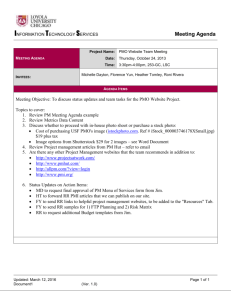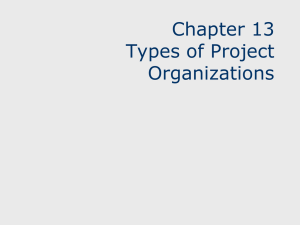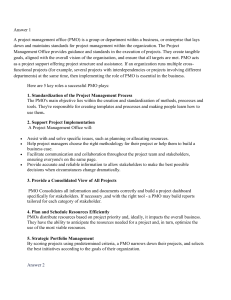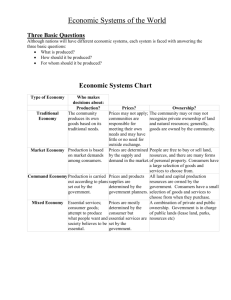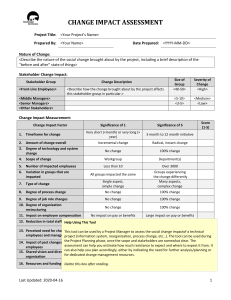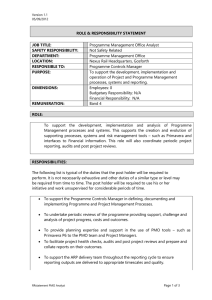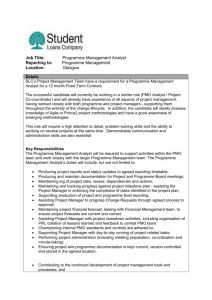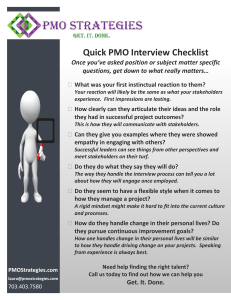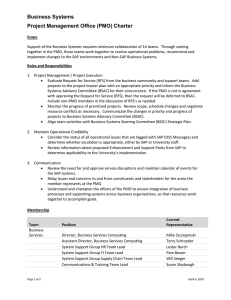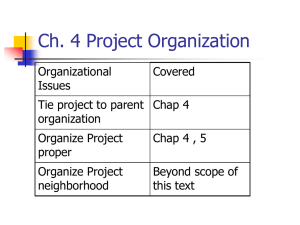File
advertisement
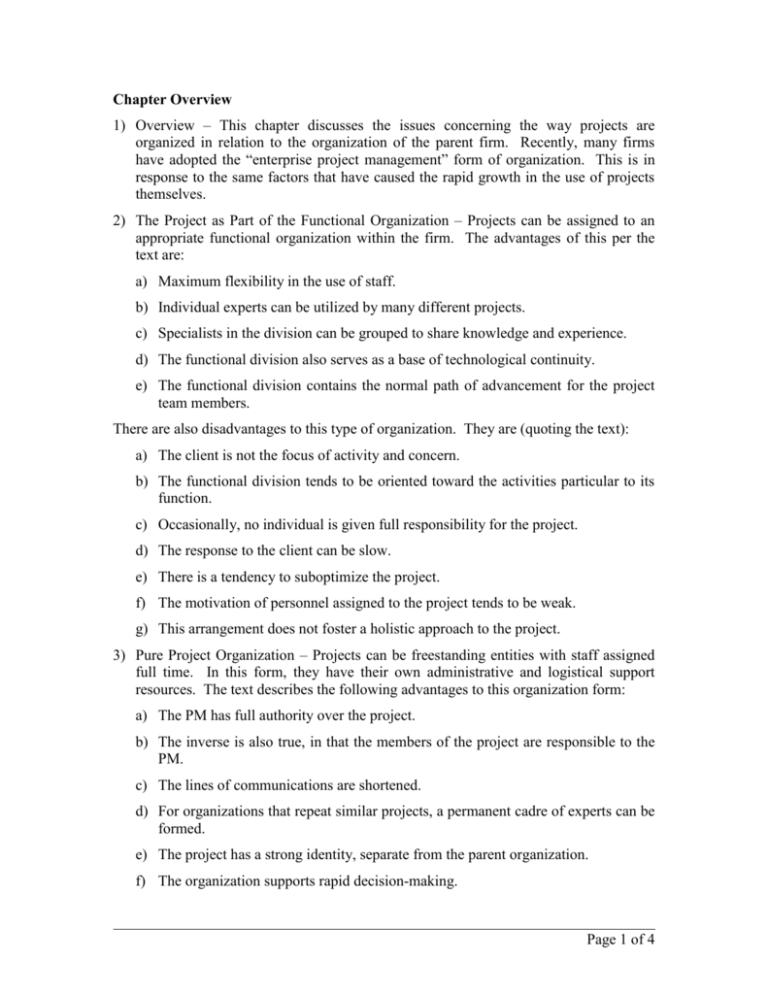
Chapter Overview 1) Overview – This chapter discusses the issues concerning the way projects are organized in relation to the organization of the parent firm. Recently, many firms have adopted the “enterprise project management” form of organization. This is in response to the same factors that have caused the rapid growth in the use of projects themselves. 2) The Project as Part of the Functional Organization – Projects can be assigned to an appropriate functional organization within the firm. The advantages of this per the text are: a) Maximum flexibility in the use of staff. b) Individual experts can be utilized by many different projects. c) Specialists in the division can be grouped to share knowledge and experience. d) The functional division also serves as a base of technological continuity. e) The functional division contains the normal path of advancement for the project team members. There are also disadvantages to this type of organization. They are (quoting the text): a) The client is not the focus of activity and concern. b) The functional division tends to be oriented toward the activities particular to its function. c) Occasionally, no individual is given full responsibility for the project. d) The response to the client can be slow. e) There is a tendency to suboptimize the project. f) The motivation of personnel assigned to the project tends to be weak. g) This arrangement does not foster a holistic approach to the project. 3) Pure Project Organization – Projects can be freestanding entities with staff assigned full time. In this form, they have their own administrative and logistical support resources. The text describes the following advantages to this organization form: a) The PM has full authority over the project. b) The inverse is also true, in that the members of the project are responsible to the PM. c) The lines of communications are shortened. d) For organizations that repeat similar projects, a permanent cadre of experts can be formed. e) The project has a strong identity, separate from the parent organization. f) The organization supports rapid decision-making. Page 1 of 4 g) There is unity of command. h) This type of organization is simple and flexible. i) Pure projects support a holistic approach to the project. This organization form also has disadvantages as described in the text: a) There can be considerable duplication of effort and staff. b) The project tends to stockpile equipment and resources just in case. c) If the project is “high technology” it may have difficulty accessing the sources of knowledge in the functional organizations. d) Inconsistencies in the application of policy and procedure often occur. e) The project takes on a life of its own. f) Team members have concerns about “life after the project”. 4) The Matrix Organization – In this form of project organization the PM borrows resources as needed from the functional departments. In a strong matrix, the PM is loaned the same specific person or persons. In a weak matrix, the PM may be the only person actually assigned to the project, and borrows capacity from the functional departments. The matrix form is a compromise that is often used because it utilizes the firm’s resources better. The text describes the following advantages of this organization form: a) The project is the point of emphasis. b) The project has reasonable access to functional experts. c) Team members have less anxiety about their fate after the project. d) The response to the client can be as rapid as a stand-alone project. e) The project has reasonable access to administrative support. f) There is better utilization of the firm’s resources. g) There is considerable flexibility in how the project is organized. There are, of course, disadvantages as well. The text describes the following: a) Because the decision-making authority may be split between the project and the various functional departments, there are many opportunities for conflict and confusion. b) In a similar vein, the sharing of resources between projects and the functional departments leads to many conflicts over priorities. c) The issues associated with shutting the project down can be as difficult as with the pure project. d) The PM will find the division between of authority and responsibility complex and challenging. Page 2 of 4 e) This organization form violates the principle of unity of command. 5) Virtual Projects – These are projects where the work crosses time, space, organizational, or cultural boundaries. These are becoming much more popular today as various work arrangement and outsourcing increases. 6) Mixed Organizational Systems – Different forms of project organization may coexist in the same firm. A variant is to setup a staff organization that administers all projects called a “project office”. 7) Choosing an Organizational Form – There are no hard and fast rules for choosing the appropriate project organizational form. The text describes the following guidelines: a) The functional form is favored if the project emphasizes the application of technology. b) The pure project is favored if the firm engages in multiple similar projects such as in a construction company. c) The matrix is favored if the project is dependent on integration but the technical experts don’t have to be all available all the time. Determining these characteristics is best done with a consistent process, specifically: a) Define the project objectives. b) Determine the key tasks and their parent organization. c) Sequence the key tasks and decompose into work packages. d) Determine the organization that will perform the work packages. e) List characteristics and assumptions associated with the project. f) Based on all these characteristics, analyze the pros and cons and select an organization structure. 7) Two Special Cases – Risk Management and the Project Office – Many organizations have formed project management offices to deal with the many managerial and administrative issues associated with projects. One issue in particular that benefits from this approach is a consistent process for the management of risk. a) Risk Management – The PMBOK® Guide Third Edition lists the following six sub processes as the elements of risk management: i) Risk Management Planning ii) Risk Identification iii) Qualitative Risk Analysis iv) Quantitative Risk Analysis v) Risk Response Planning vi) Risk Monitoring and Control Page 3 of 4 The text adds a seventh sub process: vii) Create and Maintain a Risk Management Data Bank – This sub process emphasizes the importance of consistently capturing each project’s experience with risk for the use of future projects. b) Risk Identification Theory Failure Mode and Effect Analysis - A scoring model can be applied to potential risk events to rank relative to their impact on the project. This model combines the severity of consequences, the likelihood of occurrence and the ability to detect a failure associated with the event. c) An Added Note on Risk Identification – It’s important to examine all the “environments” that a project operates in to get a complete picture of risk. In particular, many PMs ignore the external environment when considering risk. Also, positive risks are often ignored. d) Organizing for Risk Management – In general a unique risk management group should be formed for each project. For large, complex projects they may include specialists in the areas of technology, marketing, manufacturing, and the law. e) The Project Management Office – Project Management Offices (PMO) are more frequently being established to meet the need for consistent application of project management standards and methods. The text lists typical goals for the PMO: i) Establish and promulgate good project management practices. ii) Identify and distribute lessons learned from past projects. iii) Improve the success rate of projects iv) Reduce project cycle times. v) Provide consistent status data on projects. vi) Develop and maintain an “enterprise project management” system. These goals can be accomplished by the PMO acting as trainers and consultants to the rest of the organization. In addition the PMO may be called on to assist in the administration of projects through portfolio management, status reporting and project audits. PMOs aren’t magic, they can’t replace senior management’s function of articulating clear goals and providing adequate resources. Page 4 of 4
